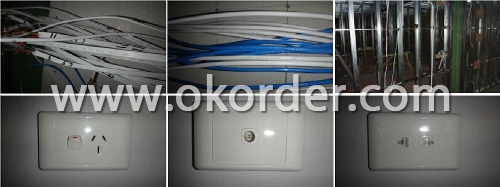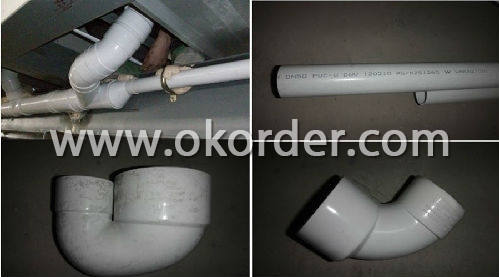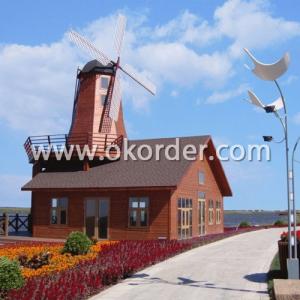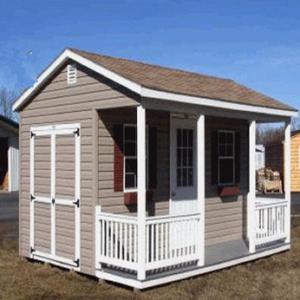School Building
- Loading Port:
- China Main Port
- Payment Terms:
- TT or L/C
- Min Order Qty:
- 80 Sqm m²
- Supply Capability:
- 20,000 Sqm/ Month m²/month
OKorder Service Pledge
OKorder Financial Service
You Might Also Like
Basic of School Building
| Place of Origin | Beijing China (Mainland) | Brand Name | LUCKY HOME | Model Number | L-P003 |
| Material | Sandwich Panel | Usage | Hotel, Office Room, Living House, Temporary House, Storage House | Packing | Flat packed |
| Framework | Steel Sructure, Q235 | Covering panel | Sandwich panel | Size | standard or customized |
| Floor height | 2.85m | Joint way | welding & bolts | Windproof grade | 10 grade (25m/s) |
| Heat conductivity | <0.032W/M.K | Container volume | 6 sets /40HQ |
Product Specification of School Building
Size | External | 6058mm(L)* 2438mm(W)* 2896mm(H) |
| Internal | 5820mm(L)* 2200mm(W)* 2680mm(H) | |
| Color | Standard: White. (May be customized as per your requirements) | |
| Steel Frame | 4mm (Hot-galvanized) | |
| Wall | 60mm EPS / PU / Rock wool sandwich panel | |
| Roof | 1st layer | 40mm EPS / PU / Rock wool sandwich panel |
| 2nd layer | 150mm thermal insulation | |
| 3rd layer | Galvanized roof tile | |
| Floor | 1st layer | Hot-galvanized steel sheet |
| 2nd layer | 75mm insulation Foam board | |
| 3rd layer | 18mm plywood base panel | |
| 4th layer | 4th layer: Vinyl Floor | |
| Door (1pc) | Steel security door (with keys): | |
| Size- 840mm*2000mm (May be customized) | ||
| Window (2pcs) | Sliding PVC windows: Size--800mm*1100mm (May be customized) | |
| Electricity | Distribution box*1 | |
| Circuit break*1 | ||
| Ceiling Lights*2 | ||
| Sockets*3 | ||
| Switch*1 | ||
| Local standard cables | ||
| Water pipes | Local standard supply and drainage pipes | |
| Usage | Accommodation, office, living room, hotel, meeting room, dormitory, shop, booth, toilet, storage, kitchen, shower room and so on. | |
Materials of School Building
A. Steel
Q255 steel adopted, meet the requirement of BCA that the yield strength must be more than 250mPa.
B. Electrical
The distribution box, circuit breaks, cables, switches & sockets, data and TV outlets are all certified to SAA, CE or CSA standard.

C. Plumbing
We use Pex-b pipes with Watermark for supply pipes and UPVC pipes with Watermak for drain pipes. All the fittings have watermark seal. All the taps, shower heads and toilets come with Watermark and are rated 3 stars to WELS Code.

D. Aluminum windows and doors
Aluminum windows and doors can be Australian standard with flyscreen and blind if required.
Advantage of School Building
1.Weight is lighter
2.Working reliability is higher
3.Excellent anti-shock and anti-impact ability
4.High degree of industrialization
5.Can be assembled accurately and rapidly
6.Interior space is large
7.Easy to make seal structure
8.Recyclable
9.Construction period shorter
Specification of School Building
1.Item: Steel Structure school building
2.Base: Cement and Steel foundation bolt
3.Primary Member: Light Steel Structure portal frame
4.Material: Q345(S355JR),Q235(S235JR) steel
5.H-beam: Welded or hot rolled
6.Purlin: C&Z Purlin (C120-C320, Z100-Z200)
7.Bracing: X&V or others made from Steel angle, round pipe ect
8.Secondary Member: Roof,Window,Wall,Door
9.Roof: Color corrugated steel sheet(Thickness 0.3-0.8) sandwich panel(Thickness 50-250)
10.Window: Alluminum Alloy or Plastic Steel
11.Wall: Sandwich Panel(EPS,PU,RW)
12.Door: Rolling door or sliding door
13.Surface Treatment: Two layer of Anti-Rust paniting
14.Accessories: Semi-transparent skylight belts, Ventillators, down pipe, Glavanized gutter, ect
15.Packing: Upon your requestment or Regular packing for exporting
Design Parameters of School Building
1)Live load on roof(KN/M2)
2)Wind speed(KM/H)
3)Snow load (KG/M2)
4)Earthquake load if have
5) Doors and windows Details
6)Crane (if have) ,Crane span, crane lift height, max lift capacity, max wheel pressure and min wheel pressure!
7)Size: width X length X eave height, roof slope
8)Or your idea!
- Q:Can container houses be built with a covered patio or outdoor kitchen?
- Container houses have the potential to incorporate a covered patio or outdoor kitchen. Due to their high level of customizability, container houses can easily be tailored to meet specific requirements, making the addition of a covered patio or outdoor kitchen entirely feasible. By eliminating sections of the container walls and introducing a roof structure, the containers can be altered to include a covered outdoor space, such as a patio, ensuring protection from the elements. Furthermore, with the installation of countertops, a sink, a grill, and other essential appliances, containers can be transformed into an outdoor kitchen. The design possibilities for container houses are limitless, and by making the appropriate modifications, a covered patio or outdoor kitchen can be seamlessly integrated into the overall structure.
- Q:Can container houses be designed with outdoor living spaces?
- Absolutely! It is definitely possible to incorporate outdoor living spaces into container houses. Although the main structure of these houses is composed of repurposed shipping containers, the design options for them are limitless. Architects and designers have come up with ingenious ways to integrate outdoor living spaces into container houses, making them both practical and visually appealing. One popular approach is to include rooftop decks or terraces on container houses. These outdoor areas can be accessed via stairs or ladders, providing an ideal spot for relaxation, entertainment, or even gardening. Rooftop decks can be designed with seating areas, dining spaces, and even outdoor kitchens, allowing residents to enjoy the fresh air and breathtaking views. Another possibility is to create ground-level outdoor patios or balconies for container houses. These spaces can seamlessly extend the indoor living areas, connecting the interior and exterior. Patios can be furnished with outdoor furniture, plants, and other elements to create a warm and inviting outdoor living space. Moreover, container houses can also feature open-air courtyards or atriums. These central outdoor spaces can be surrounded by container modules, bringing in natural light, ventilation, and a sense of connection to the outdoors. Courtyards can be designed as private sanctuaries or communal gathering areas, providing residents with a place to unwind, socialize, or engage in outdoor activities. In conclusion, container houses have the ability to incorporate outdoor living spaces. The versatility of container construction enables various designs and configurations, making it possible to create distinctive and practical outdoor areas that enhance the overall living experience.
- Q:What are the grade of office buildings?
- The so-called Grade A office building, in fact, is a popular name, and there is no fixed standard
- Q:Are container houses more affordable than traditional houses?
- Yes, container houses are generally more affordable than traditional houses. There are several factors that contribute to their affordability. Firstly, the cost of purchasing and converting shipping containers into livable spaces is significantly lower compared to the construction of a traditional house. Containers can be bought at a fraction of the price of building materials needed for a conventional house. Additionally, container houses require less labor and time to construct, resulting in reduced construction costs. As containers are pre-fabricated structures, they can be quickly assembled on-site, saving both time and money compared to the lengthy construction process of a traditional house. Furthermore, container houses are known for their energy efficiency, which can significantly reduce long-term costs. Containers are built with sturdy materials that provide excellent insulation, resulting in lower heating and cooling expenses. Moreover, container houses are highly flexible and customizable, allowing homeowners to choose the size, layout, and design that suits their needs and budget. This customization aspect allows for cost control and the ability to adapt the house to individual preferences. However, it is important to note that the final cost of a container house can vary depending on various factors such as location, design complexity, additional features, and the level of customization desired. Nevertheless, in most cases, container houses offer a more affordable alternative to traditional houses while still providing a comfortable and functional living space.
- Q:How do container houses compare to traditional houses in terms of cost?
- Container houses generally tend to be more cost-effective compared to traditional houses. The cost of building a container house is typically lower due to the use of recycled shipping containers, which significantly reduces the material and labor costs required for construction. Additionally, container houses are generally quicker to build, which further reduces labor costs. The price of a traditional house can be significantly higher due to various factors such as land cost, extensive foundation work, and the need for various building materials. On the other hand, container houses can be placed on various types of land, including small or irregularly shaped lots, potentially saving on land costs. Moreover, container houses are designed to be energy-efficient, which can result in long-term cost savings. Proper insulation and ventilation systems can help reduce heating and cooling expenses, making container houses more affordable to maintain. However, it is important to note that the overall cost of a container house can vary depending on factors such as customization, location, and the level of finishings and amenities desired. While container houses generally offer cost advantages, it is crucial to thoroughly research and plan to ensure that all necessary considerations are taken into account to accurately compare the costs with traditional houses.
- Q:Can container houses be designed with a rooftop bar or restaurant?
- Indeed, rooftop bars or restaurants can be incorporated into the design of container houses. The versatility and adaptability of shipping containers as building materials are among their key advantages. By carefully planning and designing, it is entirely feasible to integrate a rooftop bar or restaurant into a container house. Firstly, reinforcing the structural integrity of the container house is crucial to support the weight and additional load of a rooftop bar or restaurant. This can be achieved by introducing extra support beams, columns, or even additional containers to establish a stable foundation. Subsequently, modifications can be made to the container house to include stairways or elevators that lead to the rooftop area. To adhere to building codes and regulations, safety measures must be implemented, such as handrails, guardrails, and emergency exits. In terms of design, customization of the rooftop bar or restaurant is possible to cater to the owner's preferences and requirements. This may entail installing a fully functional bar, seating areas, kitchen facilities, and even outdoor space for patrons to enjoy the surrounding views. The incorporation of glass walls or open-air concepts can enhance the ambiance and create a unique dining experience. Moreover, the expandability of container houses is an added advantage. If the initial rooftop space proves insufficient, additional containers can be introduced to create a larger bar or restaurant area. Consulting with architects, engineers, and designers experienced in container house construction is vital to ensure compliance with all safety standards and regulations. With meticulous planning and design, container houses can undoubtedly be transformed into stylish and functional spaces, including rooftop bars or restaurants.
- Q:Can container houses be designed with a home theater or media room?
- Certainly, container houses have the potential to include a home theater or media room in their design. These houses are highly adaptable and can be customized to cater to the specific requirements and preferences of the homeowner. By carefully considering the layout and employing appropriate planning and design strategies, it is possible to incorporate a dedicated area for a home theater or media room within a container house. This space can be tailored to accommodate essential equipment such as a large screen, surround sound system, comfortable seating, and storage for media devices. Additionally, container houses are renowned for their versatility, allowing for interior modifications and expansions based on individual preferences. Whether the goal is to create a separate room or integrate the media area within a larger space, container houses provide the flexibility needed to realize the homeowner's vision and adapt it to their lifestyle.
- Q:Can container houses be designed to have a swimming pool?
- Yes, container houses can be designed to have a swimming pool. While the space inside a shipping container may be limited, creative and innovative designs can be implemented to include a swimming pool. One possibility is to have an underground or partially underground swimming pool, utilizing the space beneath the container. This could involve excavation and reinforcement of the ground to create a stable pool structure. Alternatively, container houses can be designed with a rooftop swimming pool, allowing for a luxurious and unique feature. With proper structural engineering and design considerations, container houses can indeed be customized to include a swimming pool.
- Q:Are container houses suitable for emergency shelters?
- Yes, container houses can be suitable for emergency shelters. Container houses are made from shipping containers that are durable, weather-resistant, and easily transportable. They can be quickly assembled and provide a safe and secure living space for individuals affected by emergencies such as natural disasters or conflicts. Container houses can be customized to include basic necessities like sleeping areas, sanitation facilities, and cooking spaces. They are also cost-effective compared to traditional construction methods, which makes them a viable option for emergency response organizations with limited resources. Additionally, container houses are reusable and can be repurposed for future emergencies, making them an environmentally friendly choice. Overall, container houses offer a practical and efficient solution for emergency shelters, providing temporary housing that is both functional and sustainable.
- Q:What are the characteristics and requirements of villa property management?
- the need to pay attention to the quality of services and requirements, and must be much higher than the general residential property
1. Manufacturer Overview |
|
|---|---|
| Location | Beijing, China |
| Year Established | 1998 |
| Annual Output Value | Above 200,000 Sqms |
| Main Markets | 9.00% Mid East 1.00% Northern Europe 20.00% Soth America 10.00% Eastern Asia 45.00% Africa 3.00% Eastern Europe 5.00% Southeast Asia 2.00% Oceania 3.00% Western Europe 2.00% Southern Europe |
| Company Certifications | ISO 9001:2008; ISO 14001:2004 |
2. Manufacturer Certificates |
|
|---|---|
| a) Certification Name | |
| Range | |
| Reference | |
| Validity Period | |
3. Manufacturer Capability |
|
|---|---|
| a)Trade Capacity | |
| Nearest Port | Tianjin |
| Export Percentage | 40% - 50% |
| No.of Employees in Trade Department | 500 People |
| Language Spoken: | English; Chinese |
| b)Factory Information | |
| Factory Size: | Above 35,000 square meters |
| No. of Production Lines | Above 10 |
| Contract Manufacturing | OEM Service Offered; Design Service Offered |
| Product Price Range | High;Average |
Send your message to us
School Building
- Loading Port:
- China Main Port
- Payment Terms:
- TT or L/C
- Min Order Qty:
- 80 Sqm m²
- Supply Capability:
- 20,000 Sqm/ Month m²/month
OKorder Service Pledge
OKorder Financial Service
Similar products
New products
Hot products
Hot Searches
Related keywords
































